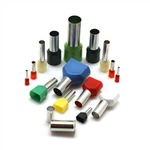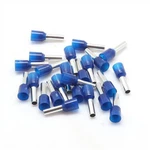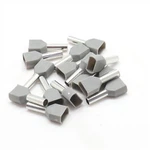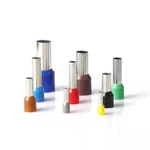Cord End Terminals
What is Cord End Terminals
Cord End Terminals are designed to terminate the end of a. cable, prior to fitting screw type terminal blocks or connectors. The crimped on cord end terminal then protects the exposed. wire strands from damage from the screw, which results in a. stronger connection.
Benefits of Cord End Terminals
They provide a secure and reliable connection for cords or cables in a wide range of applications, including electrical, industrial, and commercial settings.
They can protect cords and cables from damage caused by pulling, bending, or vibration.
They can provide strain relief, which helps prevent damage to the internal wires of the cord or cable.
They are easy to install and can be used with a wide range of cord and cable sizes.
They are available in a variety of materials, including plastic, metal, and rubber, to suit different environments and applications.
They are cost-effective and can be used in a variety of equipment and machines.
They are available in different sizes and shapes to suit different applications.
Why Choose us
Quality Assurance
Wenzhou baoteng always provide quality assurance to customers with strict standards and through multi-party quality system certification, such as ce, rohs, iso 9000.
Customer service
The company offers excellent customer service and support, making it easy for customers to resolve any issues they may have with the product.
Reputation
A company with a positive reputation is more likely to attract customers. Reputation is built through consistent quality service or products, good customer relations, and reliability.
Applications of Cord End Terminals
Electrical Installations: Cord end terminals are widely used in electrical installations for terminating wires and creating secure connections. Whether it's residential, commercial, or industrial wiring projects, cord end terminals play a crucial role in ensuring reliable and efficient electrical connections. The grey twin cord end terminals, being versatile and suitable for general-purpose applications, find widespread use in a broad range of electrical installations.
Automotive Industry: The automotive industry relies on cord end terminals for various electrical connections within vehicles. From wiring harnesses to engine components, cord end terminals are used to terminate wires and establish reliable connections. The red twin cord end terminals, designed for higher current-carrying capacities, are often employed in automotive applications where robust and secure connections are required.
Industrial Machinery: In industrial settings, cord end terminals are utilized in machinery and equipment wiring. They provide a means to terminate wires and connect them to control panels, motor terminals, or terminal blocks. The white twin cord end terminals, commonly used for low-voltage applications, are suitable for connecting wires with smaller cross-sectional areas, making them ideal for industrial machinery with specific voltage requirements.
Panel Building: Panel builders and electrical engineers use cord end terminals to facilitate efficient and organized wiring within control panels. These terminals allow for the termination of multiple wires, simplifying the wiring process and minimizing the chances of errors. Cord end terminals of different colours, such as grey, red, or white, help in the identification and organization of wires, ensuring accurate connections and ease of maintenance.
Home Appliances: Cord end terminals are employed in the manufacturing and repair of various home appliances, such as refrigerators, washing machines, and air conditioners. They are used to terminate internal wiring connections, ensuring proper electrical performance and longevity of the appliances. Cord end terminals in different colours, including grey, red, or white, may be selected based on specific requirements or wire gauges.
Electronics and Telecommunications: Cord end terminals are also utilized in the electronics and telecommunications industries. They are used for terminating wires in circuit boards, connectors, and other electronic components. Cord end terminals provide a reliable connection while allowing for easy disconnection or replacement when needed.
Enhance Safety as well as Reliability in Electrical Systems with Cord End Terminals




Prevent Wire Fraying and Splitting: One of the primary functions of cord end terminals is to terminate wires and provide a secure connection. By crimping or soldering the terminal onto the wire, it prevents fraying and splitting of the wire strands. This not only protects the integrity of the wire but also reduces the risk of short circuits, electrical faults, and potential safety hazards.
Ensure Secure Connections: Cord end terminals create a mechanical and electrical bond between the wire and the terminal block or screw terminal. This ensures a secure and reliable connection that can withstand vibrations, movement, or external forces. Properly crimped or soldered cord end terminals eliminate the possibility of loose connections, reducing the risk of electrical failures or accidents.
Minimize Contact with Live Wires: Cord end terminals, particularly insulated terminals, provide an additional layer of protection by covering the exposed metal ends of the wire. This insulation helps prevent accidental contact with live wires, reducing the risk of electric shocks or injuries. Insulated cord end terminals are especially crucial in applications where there is a higher chance of human interaction or where safety regulations mandate insulation.
Easy Identification and Organization: Cord end terminals are often colour-coded, making it easier to identify and differentiate wires within electrical systems. This colour-coding system allows installers to quickly match the terminal with the correct wire size or gauge, ensuring a proper fit and secure connection. The ability to organize and identify wires effectively contributes to efficient maintenance, troubleshooting, and modifications in electrical systems.
Improved Electrical Performance: By using cord end terminals, electrical systems benefit from improved electrical performance. The secure connection created by cord end terminals minimizes resistance, ensuring efficient power transmission and reducing the chances of voltage drops or electrical losses. This results in reliable and consistent electrical operation, enhancing the overall performance of the system.
Compliance with Industry Standards: Cord end terminals are designed and manufactured to meet industry standards and regulations. Using these standardized components ensures that electrical connections are in line with safety guidelines and requirements. Compliance with industry standards not only enhances safety but also facilitates compatibility, interoperability, and ease of maintenance in electrical systems.
Various Colour-Coded Cord End Terminals
Red
Red terminals are often associated with larger wire gauges, indicating their suitability for higher current-carrying capacities. They are commonly used for wires with a larger cross-sectional area, typically carrying more electrical current.
Blue
Blue terminals are typically used for medium-sized wires. They are suitable for wire gauges that fall between the larger sizes represented by red terminals and the smaller sizes represented by yellow or orange terminals.
Yellow or Orange
Yellow or orange terminals are often associated with smaller wire gauges. They are used for wires with a smaller cross-sectional area or lower current-carrying capacities.
Green
Green terminals are sometimes used to represent a specific function or purpose, rather than wire size. For example, green terminals may indicate grounding connections in electrical systems.
Black
Black terminals may be used in some systems to represent a specific function or to mark specific wire types or applications. For instance, black terminals could be used for wire connections related to control circuits or special wiring requirements.
White
White terminals may also be used in certain applications to represent a specific function or to mark wires with specific properties. For instance, white terminals could be used for wire connections related to communication or data transmission. If you are looking to place a bulk order for White Twin Cord End Terminals online in UK, connect with our experts at UK Cable Ties for more details.
Types of Cord End Terminals

Insulated Cord End Terminals: These terminals are designed with an insulating sleeve made of plastic or nylon material. The insulation provides an additional layer of protection, preventing accidental contact with live wires and enhancing electrical safety. Insulated cord end terminals are widely used in both commercial and residential electrical installations.
Uninsulated Cord End Terminals: Unlike insulated terminals, uninsulated cord end terminals do not have an outer layer of insulation. They are typically made of metal, such as copper or brass. Uninsulated terminals are commonly used in applications where insulation is not required or where the wire is already insulated. They are often crimped or soldered onto the wire for a secure connection.
Twin Cord End Terminals: Twin cord end terminals are designed to terminate two wires simultaneously. They have two entry points, allowing for the termination of two wires in a single terminal. Twin cord end terminals are especially useful in applications where multiple wire connections need to be made, reducing installation time and complexity.
Colour-Coded Cord End Terminals: Colour-coded cord end terminals are available in a range of colours, you can buy Grey Twin Cord End Terminals online in UK, Red Twin Cord End Terminals online in UK, and White Twin Cord End Terminals online in UK, each representing a specific wire size or gauge. The colour coding simplifies the identification and selection of the appropriate terminal size for a given wire. This helps ensure a proper and secure connection, preventing issues such as loose connections or excessive strain on the wire.
Pre-Insulated Cord End Terminals: Pre-insulated cord end terminals are designed with an integrated insulation sleeve, eliminating the need for separate insulation. These terminals offer convenience and time-saving during installation, as the insulation is already in place. Pre-insulated cord end terminals are available in various colours and sizes to accommodate different wire gauges.
Open Barrel Cord End Terminals: Open barrel cord end terminals, also known as barrel splice terminals, are used for connecting wires to electrical components, such as switches or relays. They feature an open barrel design that allows the terminal to be crimped onto the wire and then inserted into the component's terminal block or socket.

Differences Between Connector And Cord End Terminals
First, conceptual difference between connector and cord end terminals
1. Connector. It is a component often contacted by electronic engineering technicians. Generally refers to electrical connectors. That is, a device that connects two active devices and transmits current or signals.
Connector also refers to a positioning connector for connecting electronic circuits, which is composed of two parts, namely the plug-in and the connector, which can be completely separated in general. The difference between a switch and a connector is that the change of the contact state of the contact pair achieves the conversion purpose of the connected circuit, and the essential difference is that the connector has only two states: insertion and removal. The switch can realize the conversion of the circuit on the body, but standard power connectors cannot achieve the conversion on the body, and there is a fixed correspondence relationship between the contact pairs of the connector.
2. Cord end terminals. It is an accessory product used to achieve electrical connection, which is industrially divided into the category of connectors. The cord end terminals is used to facilitate the connection of the wires. It is actually a piece of metal sheet enclosed in an insulating plastic. There are holes at both ends to insert the wires. Terminals can be divided into WUK terminals, European terminal series, plug-in terminals, and so on.
Second, the difference between the scopes of the connector and the terminal
1. "Connector" is the first category, and the cord end terminals is just one of the "connector" category. A connector is a wire-to-wire connection; a connector is a wire-to-board and box connection. It is often classified into one category in practical applications.
2. The cord end terminals is part of the connector. Connector is a general term. In fact, the connectors we commonly see usually include housing and cord end terminals. The housing is mostly plastic, which plays a protective role, and the cord end terminals is a metal, which plays a conductive role.
3. Connectors and cord end terminals in the electrical and electrical fields:
A connector is commonly understood as a kind of thing that can be quickly connected with a single plug or twist without using tools.
Cord end terminals, in plain understanding, is the kind of thing that requires tools, such as screwdrivers and cold press pliers, to connect two things together, and is generally used for power input and output.
Third, the difference between the practical applications of the connector and the cord end terminals
Connectors are a subdivided field of electronic components, mainly used for the connection between circuits. In industrial production, line connections can be said to be ubiquitous, so the range of use of connectors is of course very wide and is used in various industries.
Connectors are divided into many categories, such as rectangular connectors, mil dtl 38999 circular connector, stepped connectors, and so on. The cord end terminals is a type of connector, which generally belongs to rectangular connectors. The use range of cord end terminals strips is also relatively single. It is generally used in the field of electronics and electronics, and is used for internal and external wiring of PCB circuit boards, printed boards and power distribution cabinets.
The range of use of cord end terminals is increasing, and the types are increasing. At present, in addition to PCB board terminals, the most widely used are hardware terminals, nut terminals, spring terminals, etc. In the power industry, there are special terminal strips, terminal boxes with various terminals, such as single-layer terminal, double-layer terminal, current terminal, voltage terminal, common terminal, breakable terminal, etc.
In general, "connectors" and "cord end terminals" are different application expressions that belong to the same concept, and are named according to different actual applications.
Our Factory
WENZHOU BAOTENG was established in 2013. After more than 10 years of development, it has become a comprehensive integration of industry and trade company, which engaged in design, development and production of various terminals and connectors professionally.
We have a complete research and development team, constantly developing more and more designs every year.
Quality is our culture, service is our standard, we have been holding this philosophy to provide customers with quality products. WENZHOU BAOTENG always provide quality assurance to customers with strict standards and through multi-party quality system certification, such as CE, ROHS, ISO 9000.
WENZHOU BAOTENG is engaged in the supply of electrical products with the quality of "Safe, Reliable, Suitable and Steady", observes the commitment of "Leader in science and technology, Honest operation, Quality and Customer first", provides highest quality and the most sincere services for the new and old, domestic and foreign customers.

















